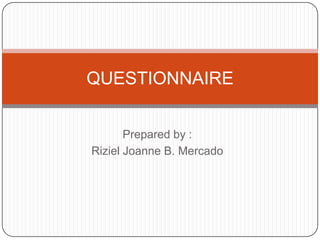The document provides information about questionnaires, including their definition, history, construction, parts, types of questions, and guidelines for formulation. Some key points:
- A questionnaire is a research instrument consisting of a series of questions used to gather information from respondents. It was invented by Sir Francis Galton and is commonly used in behavioral and social research.
- Properly constructed questionnaires can provide vital information about specific groups, people, or entire populations when administered responsibly.
- Guidelines for constructing questionnaire questions include making all directions clear, using correct grammar, avoiding double-barreled or biased questions, standardizing response options, relating questions to the research topic, and logically sequencing questions.



























































